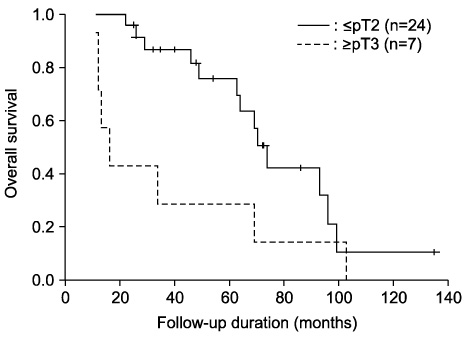Korean J Urol.
2009 Nov;50(11):1048-1053.
Long-Term Results of Radical Cystectomy in Elderly Patients with Comorbidity
- Affiliations
-
- 1Department of Urology, National Health Insurance Corporation Ilsan Hospital, Goyang, Korea.
- 2Urological Science Institute, Yonsei University College of Medicine, Seoul, Korea. sjhong346@yuhs.ac
Abstract
- PURPOSE
Radical cystectomy is a standard treatment for muscle-invasive bladder cancer in healthy individuals. However, few data are available on radical cystectomy in elderly patients with comorbidity. We determined the safety of radical cystectomy and the long-term benefit and survival outcomes after radical cystectomy in elderly patients with comorbidity.
MATERIALS AND METHODS
We reviewed the records of all patients undergoing radical cystectomy between 1986 and 2005. We identified 31 elderly patients with comorbidity, as defined by age 75 years or greater and American Society of Anesthesiologist (ASA) classification 3. We analyzed patient characteristics, presenting symptoms, surgical outcomes including perioperative complications, pathologic stage, and survival.
RESULTS
The patients' median age was 77 years (range, 75-89 years). ASA class was 3 in 31 patients. Complications developed in 8 cases (25.8%). Postoperatively, 6 of the 31 patients (20%) were transferred directly to the general urology floor. No patients died in the perioperative period or were hospitalized within 6 months of discharge home. During the follow-up period of 54 months (range, 11-135 months), 11 (31.4%) patients were alive. Cause of death was known in 20 patients, with majority (7/20) because of bladder cancer. Kaplan-Meier survival curves demonstrated that patients with organ-confined disease had a significantly longer overall survival than did patients with non-organ-confined disease.
CONCLUSIONS
Our results support the safety and feasibility of radical cystectomy in elderly patients with comorbidity. Palliation of local symptoms, local cancer control, and long-term survival benefit might be expected after radical cystectomy, especially in patients with organ-confined disease.
Keyword
MeSH Terms
Figure
Reference
-
1. Kim WJ, Chung JI, Hong JH, Kim CS, Jung Sl, Yoon DK. Epidemiological study for urologic cancer in Korea (1998-2002). Korean J Urol. 2004. 45:1081–1088.2. Frazier HA, Robertson JE, Paulson DF. Complications of radical cystectomy and urinary diversion: a retrospective review of 675 cases in 2 decades. J Urol. 1992. 148:1401–1405.3. Hendry WF. Morbidity and mortality of radical cystectomy (1971-78 and 1978-85). J R Soc Med. 1986. 79:395–400.4. Montie JE, Wood DP Jr. The risk of radical cystectomy. Br J Urol. 1989. 63:483–486.5. Sullivan JW, Montie JE. Summary of complications of ureteroileal conduit with radical cystectomy: review of 336 cases. Semin Urol Oncol. 1997. 15:94–98.6. Holmäng S, Borghede G. Early complications and survival following short-term palliative radiotherapy in invasive bladder carcinoma. J Urol. 1996. 155:100–102.7. Chang SS, Alberts G, Cookson MS, Smith JA Jr. Radical cystectomy is safe in elderly patients at high risk. J Urol. 2001. 166:938–941.8. Figueroa AJ, Stein JP, Dickinson M, Skinner EC, Thangathurai D, Mikhail MS, et al. Radical cystectomy for elderly patients with bladder carcinoma: an updated experience with 404 patients. Cancer. 1998. 83:141–147.9. Stroumbakis N, Herr HW, Cookson MS, Fair WR. Radical cystectomy in the octogenarian. J Urol. 1997. 158:2113–2117.10. Anesthesiologists, Aso. New classification of physical status. Anesthesiology. 1963. 24:111–119.11. Navon JD, Weinberg AC, Ahlering TE. Continent urinary diversion using a modified Indiana Pouch in elderly patients. Am Surg. 1994. 60:786–788.12. Rosario DJ, Becker M, Anderson JB. The changing pattern of mortality and morbidity from radical cystectomy. BJU Int. 2000. 85:427–430.13. Hanash KA, Peracha AM, Al-Zahrani HM, Merdad TA, Hafeez Kardar A, Aslam M, et al. Radical cystectomy: minimizing operative blood loss with a "stapling technique". Urology. 2000. 56:488–491.14. Park KI, Kojima O, Tomoyoshi T. Intra-operative autotransfusion in radical cystectomy. Br J Urol. 1997. 79:717–721.15. Pedersen T, Eliasen K, Ravnborg M, Viby-Mogensen J, Qvist J, Johansen SH, et al. Risk factors, complications and outcome in anaesthesia. A pilot study. Eur J Anaesthesiol. 1986. 3:225–239.16. Wolters U, Wolf T, Stützer H, Schröder T. ASA classification and perioperative variables as predictors of postoperative outcome. Br J Anaesth. 1996. 77:217–222.17. Farrow SC, Fowkes FG, Lunn JN, Robertson IB, Samuel P. Epidemiology in anaesthesia. II: Factors affecting mortality in hospital. Br J Anaesth. 1982. 54:811–817.18. Dahm P, Tuttle-Newhall JE, Yowell CW, Byrne RR, Price DT. Indications for surgical intensive care unit admission of postoperative urologic patients. Urology. 2000. 55:334–338.19. Farnham SB, Cookson MS, Alberts G, Smith JA Jr, Chang SS. Benefit of radical cystectomy in the elderly patient with significant co-morbidities. Urol Oncol. 2004. 22:178–181.20. Wood DP Jr, Montie JE, Maatman TJ, Beck GJ. Radical cystectomy for carcinoma of the bladder in the elderly patient. J Urol. 1987. 138:46–48.21. Herr HW, Sogani PC. Does early cystectomy improve the survival of patients with high risk superficial bladder tumors? J Urol. 2001. 166:1296–1299.22. Park SY, Choi HY, Lee HM. Predictive factors of advancement of the pathologic T stage after radical cystectomy in patients with clinical T2 stage bladder transitional cell carcinoma. Korean J Urol. 2007. 48:390–395.
- Full Text Links
- Actions
-
Cited
- CITED
-
- Close
- Share
- Similar articles
-
- Radical Cystectomy in Elderly Patients: A Retrospective Analysis of Post Operative Mortality and Early Complications
- Robot-Assisted Laparoscopic Radical Cystectomy
- Radical Cystectomy and Orthotopic Bladder Substitution Using Ileum
- Radical Cystectomy with Pelvic Lymphadenectomy in Bladder Tumor: Review of 14 Cases
- Treatment of bladder cancer in the elderly


